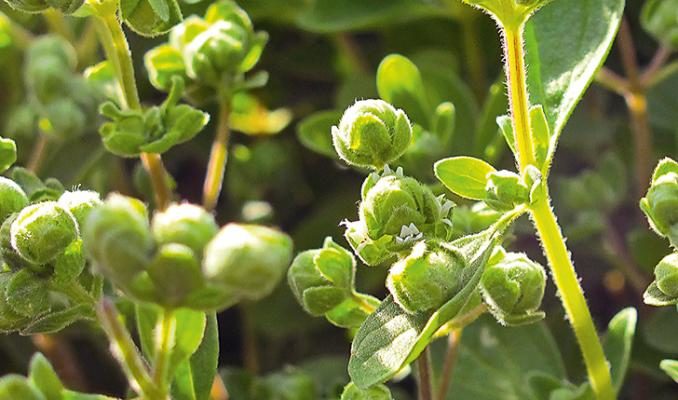
Find out more about the Marjoram plant of our Aromatherapy Herbarium blog series.

MARJORAM
Sweet marjoram
Knotted marjoram
Origanum majorana
DESCRIPTION

Marjoram (Origanum majorana) is an annual or biennial plant sixty centimetres tall, of the Lamiaceae family and native to the Mediterranean basin (Cyprus, Egypt, Turkey).
ADVICE
The application of pure essential oil of marjoram should be avoided on sensitive skin and it should be diluted by half in a carrier oil. Do not use high doses or over a long period as it presents a risk of vertigo and addiction.
DO NOT USE IN
– pregnant or breast-feeding women,
– children under the age of three years,
– persons allergic to one of the components (limonene),
– subjects with asthma without the advice of an allergologist before the first use,
– over a long period in persons with functional kidney failure (monoterpenes).
RECIPES
Anxiety
Place 2 to 3 drops of essential oil of marjoram in the wrist, on the solar plexus and along the spinal column, four times daily.
Grief
Place 1 drop of essential oil of marjoram on the internal side of each wrist and breathe in deeply.
Digestive pains
Swallow 2 drops of essential oil of marjoram on a neutral tablet, in a teaspoon of olive oil or a sugar lump as soon as the pain appears, if it is occasional, or before each meal over 24 hours, if chronic.
Sinusitis
1 drop of EO of Eucalyptus radiata, 1 drop of EO of marjoram.
Take 2 drops on a neutral tablet three times daily for five days.

It grows very well on poor soils, but will suffer in wet cold. The stems are hairy, with rounded and slightly dentate green leaves.
Marjoram was born from an accident. At the time when the world smelled good, Amarakos was in charge of caring for perfumes at the court of Cinyras. One day he had the misfortune of breaking a container with an exquisite content, and “he shrivelled in shame”. The gods took pity on him and transformed him in marjoram or oregano (amarakos). In Egypt, marjoram was part of the salves and fumigations. The Greeks applied it in plasters on painful limbs and offered it to the gods. Dioscorides identified the main virtue of the plant: “It fights acid fermentations of the stomach.” According to the “Edict of Maximum” (301 A.D.), was sold in Rome at a hundred dinerii the pound, i.e. more than rose oil. In the Middle Ages, marjoram called “flea-cover”, was good luck and cured almost anything. The famous German physician Fabricius von Hilden (1560-1634) used to cure the famous general Wallenstein from a “head cold” who recompensed him with “two hundred gold écus”.
CULTIVATION AND PRODUCTION
Marjoram is cultivated up to altitudes of two thousand metres. Its small lilac and white flowers blossom in July-August.
FRAGRANCE
The scent of marjoram, fairly similar to that of thyme, is more delicate than that of oregano.
EXTRACTION AND YIELD
The distillation of a hundred kilograms of flowering tops provides two hundred to three hundred grams of a pale yellow to slightly amber essential oil, with a yield of 0.2% to 0.3%. The leaves are used as a condiment.
CHEMICAL FORMULA
Its active ingredients are mainly monoterpenes (40%) and monoterpenols (50%), including terpinene-1-ol-4. Unlike oregano (or pizza herb), marjoram does not contain any phenols.
Not to be confused with Spanish marjoram (Thymus mastichina) with very different properties.
MAIN INDICATIONS
An anti-infectious and fungicide, essential oil of marjoram is useful against respiratory infections and mycoses. The queen of zen, its soothing and re-equilibrating action makes mood disorders go away and dissipates fatigue.
It is precious for quitting smoking, it spares us from irritability and bulimia. It is brilliant in case of difficult digestion, soothes rheumatism pains and calms obsessive sexual ardour. Finally, a drop placed on the internal side of the wrists helps overcoming upsets or grief.


Leave a Comment